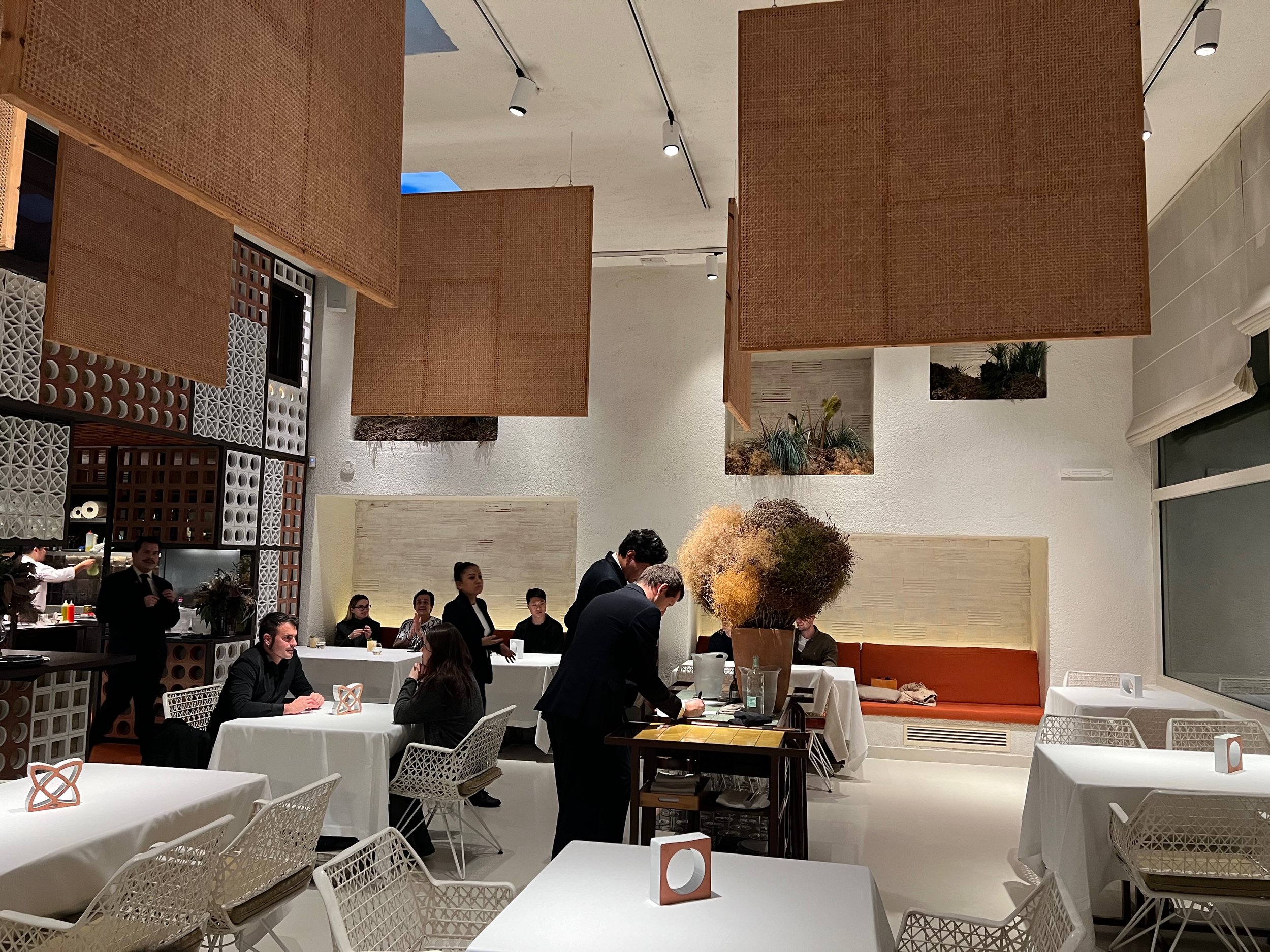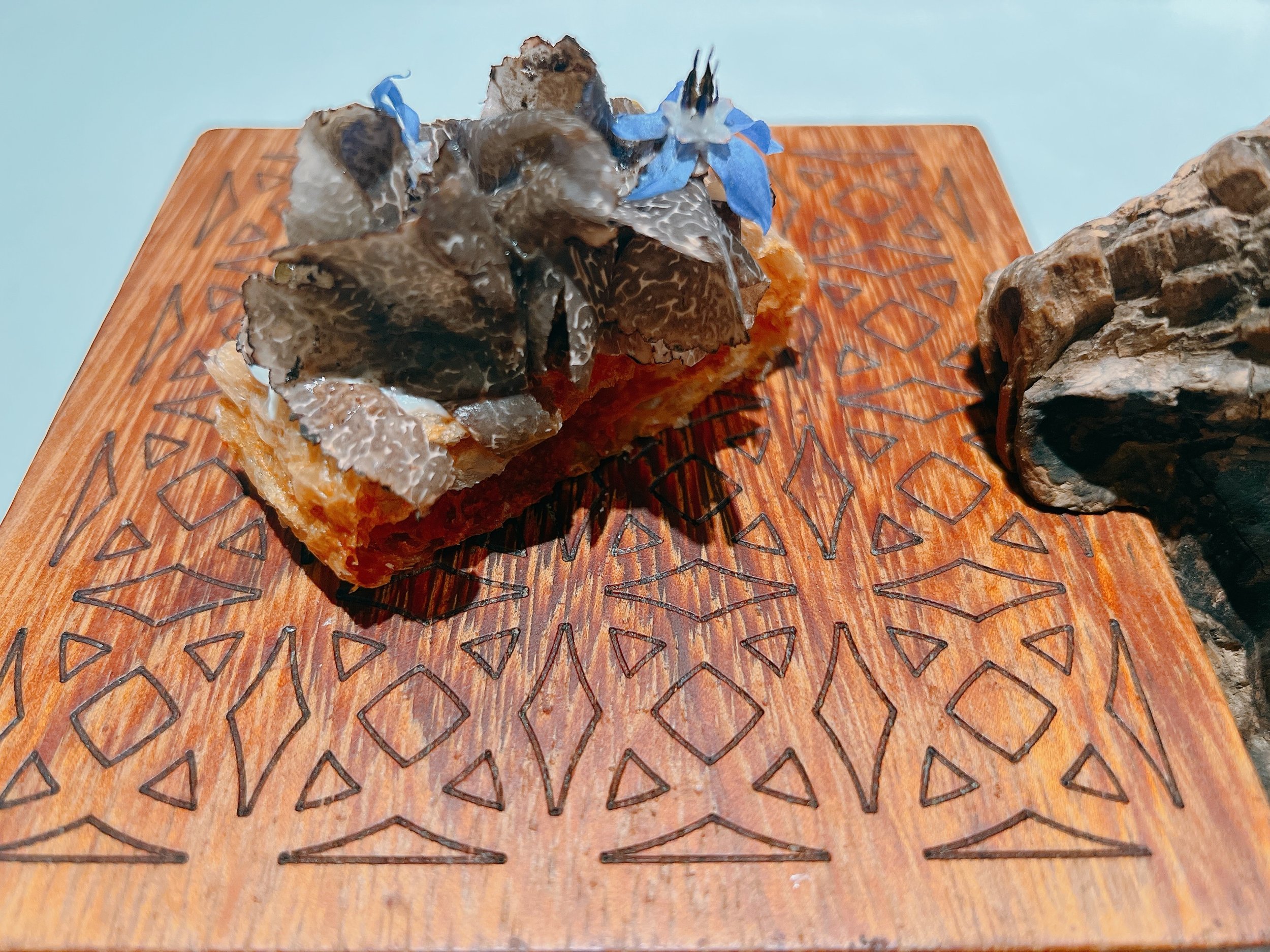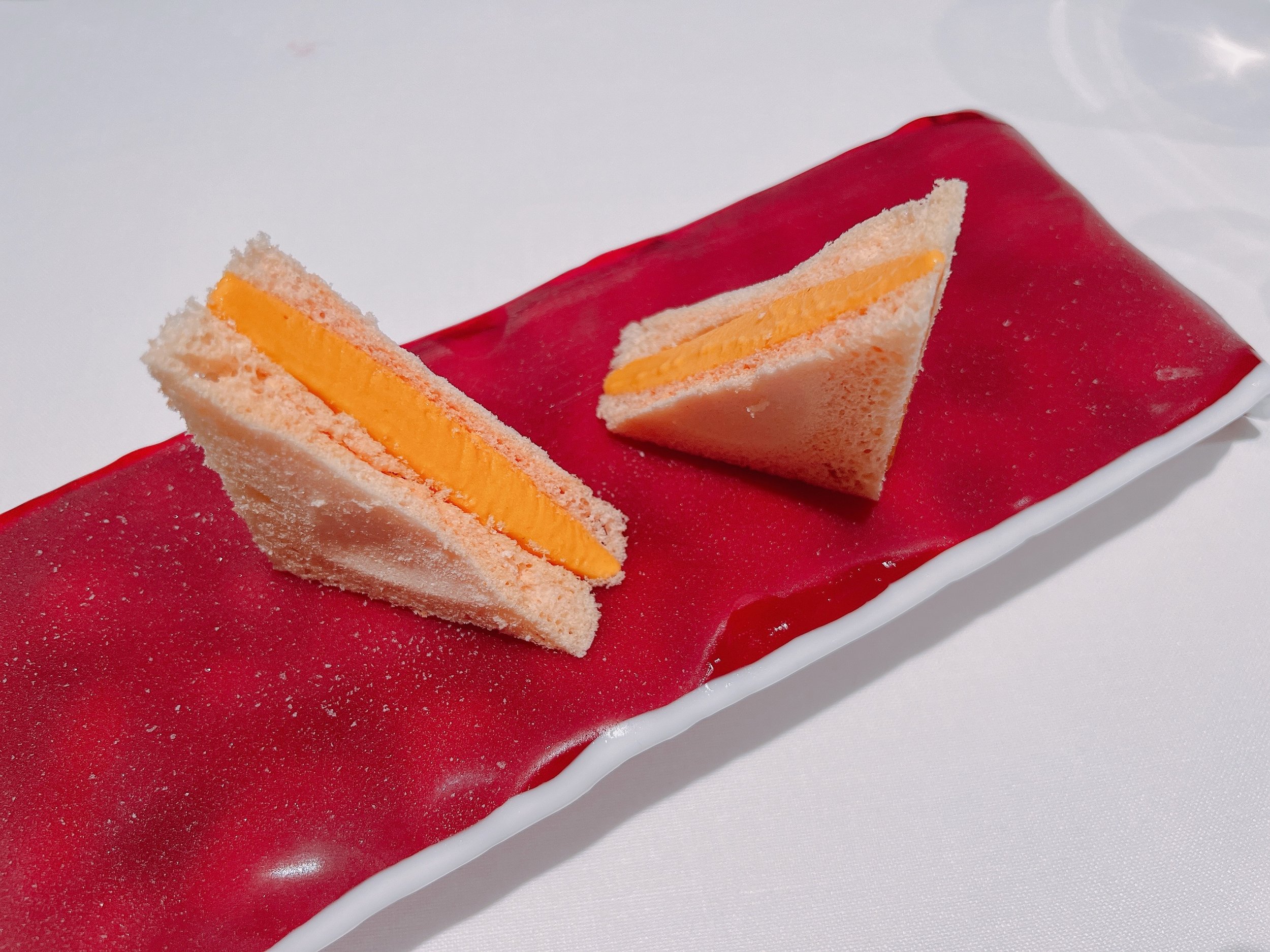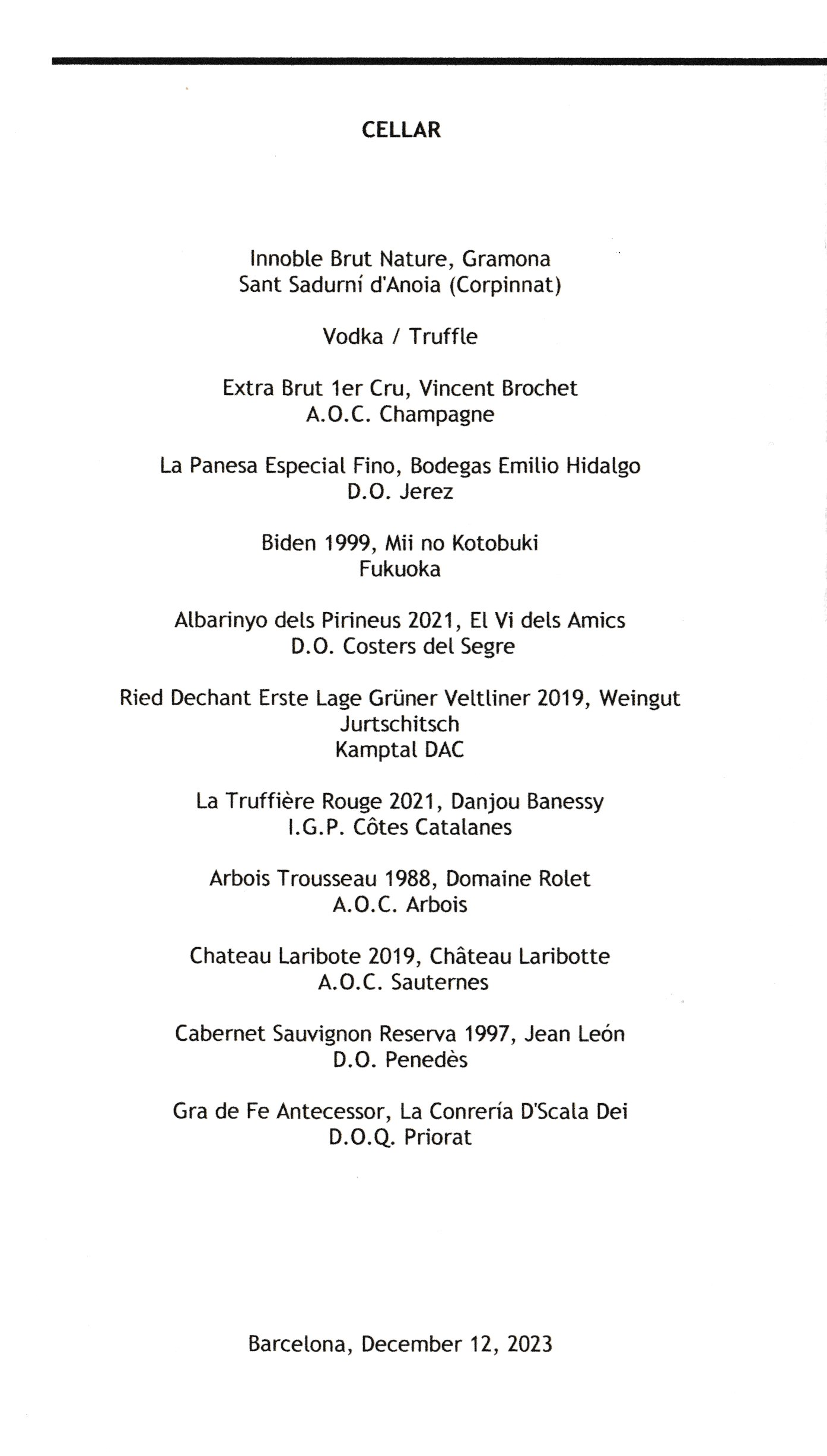Disfrutar - Barcelona
Rating: 18/20
Where: Barcelona, Spain
When: Dinner for 2 on 12 December 2023
Cost per Person: Tasting menu 275 Euro, Wine pairing 145 Euro
Accolades: 3 Michelin Stars, #2 on Top 50 Restaurants list (2023)
Why: Molecular cuisine in the spirit of El Bulli; technically impressive cooking
“El Bulli” was one of the most famous fine-dining restaurants ever - its culinary wizardry and ample use of molecular gastronomy are legendary. But sadly, the restaurant's business side was not quite of the same caliber, managing to lose money even though every year millions of reservation requests vied for only a few thousand seats, and El Bulli served its last meal in 2011. But luckily, there have been a number of spiritual successors. One of them is Barcelona's “Disfrutar”, which opened in 2014 and is run by three chefs who originally met at El Bulli.
Scoring a reservation at Disfrutar might not be as impossible as it was at El Bulli, but it is still not completely effortless. Nominally, the restaurant is fully booked for one year ahead of time. So, if one is in no particular hurry, it's indeed pretty easy to make a reservation at midnight Spain time for a meal exactly one year in the future. The alternative is to bank on last-minute cancellations. Since reservations require neither prepayments nor deposits, it is not unsurprising that many people change their minds over a year's time, and don't reconfirm their reservations five days prior. If one is able to make it to Barcelona on a few days notice, this is not a bad option for getting a table at Disfrutar, and that’s essentially how we ended up here, only two weeks after the restaurant received its third Michelin star.
When we arrived at Disfrutar, we were positively surprised by the staff's humbleness; they thanked us for “coming here on such short notice”. Many restaurants of this caliber would have had had an attitude of “you should be thankful to us for taking you off the waiting list”. Not so at Disfrutar, apparently. After a stroll past the open kitchen and a handshake with one of the three chefs we came to the dining room. White walls, high ceilings and skylights painted with cloud motifs, all were meant to evoke the Mediterranean fishing village where the chefs opened their first joint restaurant “Compartir”. Even though the tables were covered with white table cloths, the ambiance was refreshingly casual.
Disfrutar offered two tasting menus: the “Classic” menu was a greatest hits collection of the restaurant's past creations, and the “Festival” menu consisted of recently invented dishes. We went for the Classic menu - a choice apparently shared by most of the tables around us. An alcoholic and a non-alcoholic beverage pairing were available, in addition to dozens of wines by the glass and an extensive wine list. The alcoholic pairing consisted mostly of wines, but also included a vodka-based drink, an aged sake and a glass of mead. The paired wines might not have been mind-blowing by themselves, but they were decent and went pretty well with the food. Given the adventurousness and unpredictability of the menu, one might as well go all in and get the pairing. Ordering by the bottle will probably result in a poorer wine-to-food fit.
At the beginning of our meal, we didn’t receive a traditional menu, but instead a paper listing the emotions that the food was supposed to evoke. A bit silly, yes, but also a sign not to expect anything in particular, and to just go with the flow and see where it took us.
All servers coming to our table introduced themselves by name, and we were encouraged to say whether we wanted the food to arrive faster or slower, and to let the staff know a dish or two ahead of time in case we needed a smoking break. Our server also recited a list of ingredients in case any of them made us feel queasy - in that case they would be replaced. All in all, a straightforward way of making us feel welcome and emphasize that the staff would do their best to have us enjoy our meal - exemplary service even at the three-Michelin-star level. Since we didn't ask for any modifications to our dining speed, I was a bit surprised that we were the last guests to leave, even though we had arrived only a few minutes after opening time. All the note-taking and photography costs some time, apparently.
On to the food. Our first course had to be eaten promptly to keep it from melting. A frozen ladyfinger was made from passion fruit, rum and peppermint. A crunchy wafer underneath allowed the frozen dish to be picked up. This was a light, but tasty beginning to our meal. I particularly liked the fact that one could clearly identify all the individual ingredients 18.
Next, a dish presented on top of three rose petals. Two contained a spherized drop of rose water and gin. The third held what looked like a white raspberry, but was actually a lychee granita in the shape of a raspberry. The lychee had a lovely flavor, and the rose water/gin drink was quite good as well 18.
Buried in a bowl full of “sand” was a beet meringue topped with yogurt powder. Our server shook the bowl until the meringues shifted to the top. Very tasty, airy and light. Again, both ingredients were easy to recognize 19.
The next dish came paired with a truffle-infused vodka, which was quite nice by itself - there was no sharpness, clearly a high-quality vodka. Sheets of potato starch had been baked into an airy bread similar to a millefeuille. It was topped with burrata, fish roe and shaved black truffles. This was another dish that could be described as very airy and light. It also boasted great flavors, a nice crunch, but was a tad fatty. Creatively, this was a 20 - who would think of making bread directly from potato starch sheets? Flavorwise, it was still great, but a similar effect could have been achieved using less unusual methods 18.
A bread roll was introduced to us as a “Chinese bun”. It was deep-fried on the outside, and its hollow center contained sour cream and caviar - a surprisingly large amount of caviar in fact. In a sense, this was a reimagined version of a blini with creme fraiche and caviar. Very nice, but it would have been even better had the bun not been quite as oily 18.
More caviar in the next dish. A thin slice of toasted bread was topped with caviar and a cloud of solidified bubbles of butter. The caviar was again excellent, but I was a bit puzzled by the butter. Yes, it was a neat trick to get it into this airy form, but in the end, it tasted just like butter. Hard to rate 17.
Gazpacho sandwich anyone? Gazpacho sorbet was served between two slices of tomato meringue. On the side, we received an empty wine glass spritzed with vinegar. The vinegar smell was meant to accentuate the sourness of the gazpacho, but was dangerously strong, and (in my opinion) not really necessary for the dish. The creamy gazpacho was excellent in flavor, and the light airy “bread” was a great addition. Clever techniques didn't compromise a delicious dish 19.
One of the most famous pintxos of San Sebastian is the trio of olives, anchovies and pickled peppers stacked on a toothpick. Our next course was a deconstructed version of the same. A larger piece of marinated mackerel sat next to two smaller pieces of anchovy. Also present were the insides of a pickled pepper, an olive-shaped shell filled with olive juice, and plenty of good olive oil. It was neat to use two kinds of fish that looked similar and tasted very differently, but were equally delicious. A lovely rendition of this classic tapa 19.
The next three dishes were all based on mushrooms and were served with a wonderful aged sake. First, a “mushroom leaf”: dried mushroom soup in the shape of a crunchy leaf. Bursting with concentrated mushroom flavor this was the platonic ideal of what mushrooms taste like - excellent 20. Well, if I had to nitpick, this dish really stuck to one's teeth, but that was a price we were happy to pay.
Mushroom Act II: an egg shell was filled with a mushroom jelly and topped with a deep-fried dough ball filled with liquid egg yolk (a “crispy egg yolk” in the words of our server). The jelly was lovely, but not as strongly flavored as the preceding leaf. And it went nicely with the creamy egg yolk. Similar to previous fried dishes, I felt that the crunchy sphere could have been a bit less fatty 18.
For part three of the mushroom saga, we received a bowl that contained: two real mushrooms, two “fake” mushrooms (really mushroom-shaped jellies filled with mushroom consommé), a large oyster, an oyster leaf and a sauce made from mushroom vinegar and vegetable broth. For a final bite, there was also a small piece of pineapple confit - a palate cleanser of sorts. The vinegary, sour sauce was delicious, the real mushrooms were ironically much better than the fake ones, and the oyster was a tad too big and meaty compared to the rest of the dish. But overall, very lovely 18.
The next dish provided another example where the use of amazing culinary techniques was mostly gratuitous. The “multi spherical technique” had been applied to a pesto sauce, creating what looked like an undulating green caterpillar of little pesto-filled spheres. The pesto was quite light and its skin pretty thick, and as a result it didn't add much flavor to the rest of the dish. Said rest was quite good, though. Two cubes of smoked eel were topped with pancetta and surrounded by a Parmesan sauce, Parmesan cubes, roasted pine nuts and pistachios. The Parmesan sauce was heavenly, but the pancetta overshadowed the supposedly starring eel 18.
The following dish was an even more explicit ode to carbonara. A consommé of Iberian ham had been solidified into penne-shaped tubes. This “pasta” was served with cubes of ham and Parmesan and then topped with a carbonara mousse, freshly ground black pepper and shaved Parmesan. The carbonara sauce was quite nice, but I dare say that I would have preferred a really good penne carbonara to this reconstructed version. Technique? Amazing, a 20. Taste? Good, but not quite as mind-blowing 18.
The pescatarian alternative to the “pasta” was an onion soup that came with egg yolk, black truffles, onion bread and onion salt. Great flavors, dominated by the excellent soup made of caramelized onions. Lovely 18.
Next, a dish that pushed the boundaries of what “cooking” means, but not in terms of elaborate techniques but rather in terms of minimalism. A plate was covered with a light tomato gel. Laid on top of the gel were a dozen different sprouts. The dish was accompanied by a legend specifying which plants the sprouts came from, and what taste to expect from each (often, but not always, the same as the grown plant). The flavors of the sprouts were indeed very distinctive, with the tomato gel serving as a palate cleanser in between. Very interesting, but nearly impossible to rate - this might be a 14 or a 20 depending on your preferences. For its audacity alone, I'd say 18.
The following dish came in two parts. On the right: a tomato biscuit topped with fish roe that was based on a traditional Catalan Christmas cookie. On the left: a liquid salad served in a cocktail glass. The cookie was airy and a bit too dry by itself, but that’s where the wonderful “salad” came into play. It actually tasted of salad leaves, and contained a sphere of spices (garlic maybe?) and some granita at the bottom of the cocktail glass. Salty, savory and full of flavor 18.
Hake was served with potatoes, a parsley foam, saffron aioli and a suquet sauce. Apart from the foam, and the fact that the “potatoes” had been shaped from mashed potatoes, this was actually a pretty traditionally prepared dish. The fish was firm and perfectly cooked, and the mashed potatoes soaked up the wonderful sauce - which is probably the reason why no “normal” potatoes were used. On the side was a cup filled with a seafood soup that was topped with a foamy potato puree. Arguably the broth was even better than the fish. Very good 18.
Golden goose eggs were the inspiration for our next dish. A hard-fried egg white was topped with an “egg yolk” - actually a spherized spicy prawn consommé. Next to it: pieces of prawn and dollops of a nut sauce. Spices, ginger and peanuts gave this dish a slightly Asian touch. I loved the crunchy texture of the egg white - and this is from someone who usually avoids fried eggs at any cost. Very, very good 19. Technically and creatively, a 20.
Next up: a little tarte tartine made from crispy corn, topped with foie gras and spherized corn. It was served in a box using a partial mirror, creating an optical illusion that made the tarte appear in a different location from where it actually was. Not sure why this effect was relevant to the dish, and as if to make that point, our server disassembled the box before we could even reach for the imaginary calorie-free bite. The real dish was a bit heavy thanks to the creamy foie gras. Only the slightly sweet cracker tried to balance the richness of the rest of the dish 15. The pescatarian alternative to this dish was a crispy corn roll filled with avocado cream. Not surprisingly, this was much lighter than the original. The sweet roll and lovely avocado were a nice match 17.
At this point, we had reached the final savory course of the night. Pigeon was placed on top of kombu seaweed, which was shaped almost like spaghetti. On the side: sauces made from almonds and grapes, an actual almond, and a grape filled with sake and grape puree. The meat was very good: flavorful, perfectly cooked and not too gamey. Among the sides, the grape stood out as particularly delicious 18. The pescatarian alternative replaced the pigeon with a sea cucumber. Interestingly and unusually, we were only served the insides of a peeled sea cucumber. Earthy and smoky, it was pretty good, but didn’t hold up to the stronger flavored seaweed 17.
An apple cider was made by first “fermenting” apple juice table-side with some dry ice - presumably to give it some fizziness? Adding the smoke of burnt oak chips made this a smoked apple cider. It came with a walnut that we were instructed to crack: its shell contained half a walnut and a little cube of cheese, as only walnuts at Disfrutar do. The slightly fizzy cider was a nice pre-dessert, but I'm not sure why it needed the walnut (or the cheese, for that matter). They were probably foreshadowing the following course 18.
More variations of walnuts came next - in the form of a cheese course. In the middle of the plate was a cheese from the Basque Country, surrounded by four kinds of walnuts: a raw walnut, a walnut shell (!) that had been soaked continuously to prevent it from hardening, a walnut candy and a solidified walnut “liquid”. The shell had a consistency close to jelly, the candy was sweet and crunchy, and the “liquid” was made into an (also) very sweet candy. Taste 18, ideas 20, for an average of 19.
Our first dessert had an unusual main ingredient: cucumbers. Cucumber sorbet, cucumber granita, cucumber slices and some non-cucumber ingredients (ginger ice cream, puffed pork skin, hoisin sauce, black sesame, honey) made for an unusual dish. The cucumber, sesame and ginger worked quite well together, but the rest of the ingredients were oddly savory: the pork skin was on the oily side, and the hoisin sauce felt a bit too intense for the rest of the dish 17.
More black sesame in the next dish: a black sesame cone was filled with ice cream and wild strawberries. Essentially a light dish of strawberries and cream with the addition of a crunchy, nutty sesame shell. Not bad at all 18.
The following dessert was a play on an apple tarte, having lost the “tarte” part somewhere along the way. An apple had been fermented inside a vacuum sealed plastic bag until it turned brown and very soft - the lack of oxygen in the bag made sure that the fruit wouldn't rot. The apple came with a vanilla whipped cream and a noisette ice cream. Mixing everything together made for a nice dessert 17.
Six final petit fours came arranged on a garden trellis. A passion fruit and mango bonbon had an acidic liquid center. Both fruit flavors were clearly identifiable 17. Peppermint/cacao cotton candy was a sweet wintry treat 18. A basil chocolate leaf tasted more of basil than of chocolate 17. Clusters of pine nuts and pineapple were nicely crunchy, but had only a light pineapple taste 15. A raspberry marshmallow was slightly creamy and had a good raspberry flavor 17. An airy piece of matcha tea and yuzu melted instantly in one's mouth, and tasted a bit of white chocolate, and more of yuzu than of matcha 16.
Overall: A four-hour tour de force of molecular cuisine; there are few places in the world where such a meal will be prepared at this level and with such determination. If one is looking for impressive culinary techniques and dazzling displays of creativity, then one is at the right place at Disfrutar. Tastewise, our meal was also consistently very good, but maybe not as “out of the world” as one might hope given the elaborate food science. Definitely worth a visit though, if one comes here with an open mind 18.





































